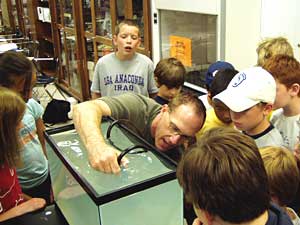Audio
Photos
Resources
| |||||||||||||||||||||||||||||||||
July 26, 2005
 |
| Walt Johnson teaches Ocean Aquarium, a summer school class for gifted students, at Maple Grove Junior High. (MPR Photo/Tim Pugmire) |
Maple Grove, Minn. — Hundreds of gifted and talented students from 13 school districts in Hennepin County gather every year for the West Suburban Summer School. They enroll in classes designed to meet their unique learning needs. The offerings include classes like Alien Worlds, Math-mania and Orienteering.
This gifted and talented program serves students in first through ninth grades. Julie Ann Queensen will be a seventh grader this fall at North Junior High School in Hopkins. She enrolled in a class at Maple Grive Junior High called Ocean Aquarium.
"It's just cool, because you get to learn all about all these things, and like get to keep your own fish," Queensen said. "It's better than like actually buying the stuff, then coming home and going like, OK, so what do I do now? You actually learn about how to do the stuff, and it's really fun."
West Suburban Summer School is a tuition-based program. Parents pay at least $175 per class.
School finances have been tight in recent years, and many Minnesota school districts cut back or eliminated programs for gifted and talented kids. State support for such programs dried up years ago.
Gary Bowman, a teacher in the Osseo school district, helps run the Maple Grove summer program. He's pleased the state is providing new money for gifted and talented.
"In my building that I teach at, we have a gifted and talented teacher, and his hours were cut," Bowman said. "And I know the program in Osseo in general, the people that teach that program, their hours have been cut. And their amount of time in their buildings has been cut down. I know they are just jumping for joy that they'll hopefully have more hours, and to make more contact with students and to meet more of their needs."
State officials have never required school districts to identify gifted and talented kids or offer special programs. Still, many school district leaders have made it a priority.
Teresa Boatman, president of the Minnesota Council for the Gifted and Talented, said they've seen too many bright students opting for private school or home school. Others simply drop out.
"A child who's gifted who is 11 thinks like a 13- or 14-year-old," Boatman said. "So at 11 they're ready for algebra. They're ready for higher level sciences. But if it's not available in the schools, then those kids just languish there."
Boatman estimates there are 80,000 students around the state who demonstrate classroom abilities well above the norm for their age group. She says those students generally score in the top 5 percent on standardized tests, or their IQ tops 130. But Boatman said there's no clear standard for identifying the gifted and talented.
"A highly verbal gifted kid is pretty easy to find. You look at their vocabulary and you go, I can find that one," says Boatman. "But there's visual spatial ability. There are kids who are really high in math, but then their reading is poor."
"And we need to work with the schools to help identify these kids," Boatman says. "That's part of why this funding is really important, is at least they can make the first step of getting good identification materials in place, and then they can do the programming based on who they have in their pool."
The new gifted and talented funding is based on total student enrollment. Districts will receive $4 per student this year, and $9 per student for the following school year.





